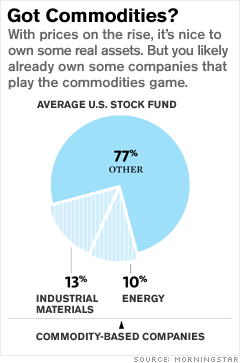
Until recently, individual investors have largely stayed away from commodities - for good reason. Unlike bonds, hard assets such as gold or oil generate no income. They just sit there like, er, a lump of coal. Whereas stocks allow you to bet that a business will create value and grow over time, commodity investments are just a guess about prices. And those prices can swing wildly.
Commodity bulls say the world has changed, making real assets not only attractive but necessary. Thanks to demand from emerging economies like China and India, just about anything you can grow or mine is trading at or near all-time record highs. "It's unlikely we'll go back to the `good old days' of markedly lower commodity prices," says strategist Stuart Schweitzer of J.P. Morgan Private Bank.
Commodities were a great hedge against rising costs in the '70s. Between 1970 and 1981, when inflation was at 7.9% a year, hard assets gained more than 17% annually. But that was one decade. Bernstein Global Wealth Management studied commodity prices over a half-century and found they rose an average of only 2.5% a year. That's lower than the long-term rate of inflation.
Commodities do add diversification because they move out of sync with stocks. But for most investors a commodity-related fund is optional and a 5% stake is more than sufficient; at today's prices, you can take your time getting there. "Everyone has beaten you to the punch," says Jeremy Grantham of the investment management firm GMO. Besides, you already have exposure to commodities if you own a typical U.S. stock fund, which holds nearly 25% of its assets in energy and natural-resources stocks. Ditto if you own a foreign stock fund, which likely invests in countries that produce commodities.
The verdict: Commodity plays are overrated. You need only a little and may already own some.
More galleries
